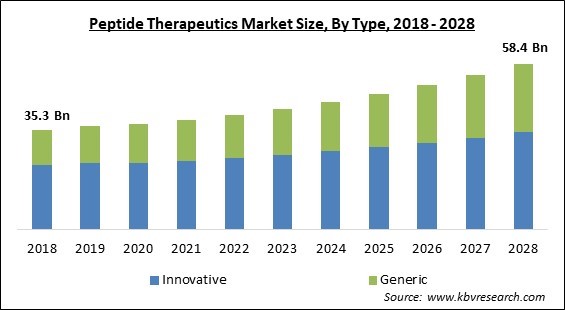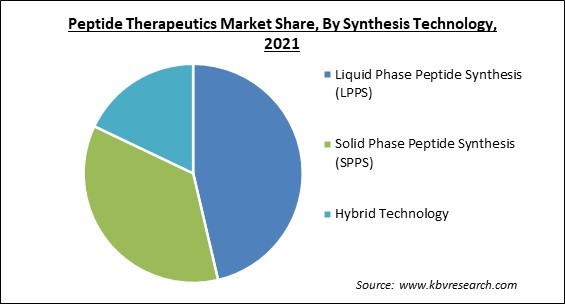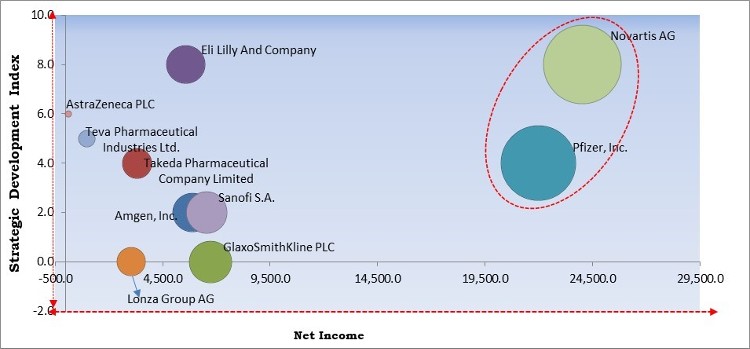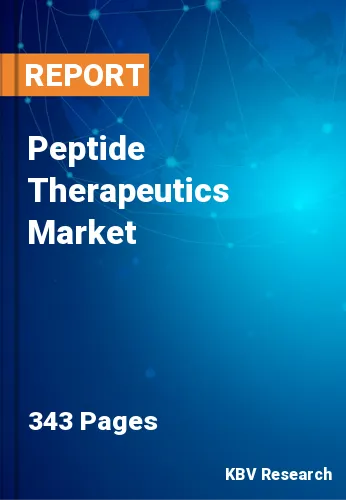The Global Peptide Therapeutics Market size is expected to reach $58.4 billion by 2028, rising at a market growth of 6.3% CAGR during the forecast period.
Peptide therapeutics are polypeptides or peptides (oligomers or short polymers of amino acids) that are utilized to treat disorders. Peptide treatments replicate natural peptide functions such as hormones, neurotransmitters, growth factors, ion channel ligands, and anti-infectives. Because peptides may be digested by the body, they are thought to be reasonably safe and well-tolerated.

Liraglutide, the most popular diabetic medicine on the market, contains a lipid chain that increases plasma circulation and provides long-term absorption. Liraglutide is a GLP-1 agonist that self-assembles itself into an alpha-helical structure and only needs to be consumed once a day. Liraglutide's half-life in the blood is lengthened by approximately 13–14 hours due to lipid conjugation of a palmitoyl chain to a lysine residue at position 26. This is attributed to the palmitoyl chain's ability to bind albumin non-covalently, delaying DPP IV's proteolytic action and enabling fast renal clearance. The inclusion of the lipid chain could further extend the half-life by preventing the DPP IV enzyme from degrading sterically.
Lanreotide, an octapeptide, is another peptide that may self-assemble. This medication is a synthetic counterpart of the peptide hormone somatostatin, which is used to alleviate acromegaly (a malfunction where the body produced excessive amounts of growth hormone). Lanreotide assembles itself into monodisperse liquid crystalline nanotubes when exposed to water. The nanotubes are composed of dimers that self-assemble into a 2D lattice that is kept together by antiparallel ß-sheets and lateral chain connections. Studies on self-assembling amyloid aggregates created by peptide hormones and neuropeptides have provided more insight into how self-assembly, as well as peptide hormones, are connected.
COVID-19 was addressed using novel peptides that have been repurposed as medicines. Researchers throughout the world are still looking for chemicals that can either stop SARS-CoV-2 infection and replication or relieve symptoms caused by the virus. The FDA revised its definition of a biologic to include chemically produced polypeptides with a length of more than 40 amino acids but less than 100 amino acids (synthetic proteins) and synthetic peptides with a length of 40 amino acids or less (synthetic peptides). There were 21 peptide medicines in development for the treatment of COVID-19, including 15 synthetic peptides in therapies for the treatment of ARDS and other respiratory disorders caused by SARS-Cov-2 infection.
Cardiovascular disease (CVD) is still the major cause of death and morbidity around the world. Many interventions are being tested to ameliorate pathological cardiovascular problems, however, there have been few new drugs licensed for intervention or treatment. As a result, novel techniques for treating CVD are urgently needed. The treatment of contributory risk factors and underlying mechanisms, such as inflammation, obesity, hyperglycemia, and hypercholesterolemia is frequently used to prevent vascular problems. The pharmaceutical industry has traditionally resisted using peptides as therapeutic agents due to their limited stability, size, rate of breakdown, and poor distribution. However, there has been a renaissance in the development of peptides and their synthetic derivatives for therapeutic intervention in recent years.
Cancer is the second leading cause of death, accounting for a considerable number of deaths all over the world in 2013. The rate of cancer in developed countries is significantly higher than in developing countries. The prevalence of known risk factors is predicted to rise in these under-developed nations due to population growth and aging, as well as an increased prevalence of known risk factors. Lung cancer is the largest cause of death from cancer in men around the world, but only in industrialized countries, while breast cancer is the leading reason of cancer death in developing countries. Somatic gene mutations that change the function of the proteins they encode have been linked to cancer. Most solid tumors, like those of the brain, colon, breast, and pancreas, exhibit somatic changes.

Natural polypeptides like hormones, growth factors, and neurotransmitters, unlike synthesized peptide medications, are considered to play an important function in normal physiology. Membrane impermeability and in vivo instability are two key disadvantages of peptide medicines. Proteolytic degradation of peptide medicines in serum diminishes the bioavailable concentration and reduces the drug's half-life. To keep the medicine at a clinically effective concentration, routine dosing may be required. To avoid proteolytic degradation and enhance the in vivo half-life of peptide medicines, a variety of chemical modification approaches have been used.
Based on Type, the market is segmented into Innovative and Generic. In 2021, the innovative segment procured the highest revenue share of the peptide therapeutics market. The constantly rising growth of the segment is owing to significant R&D investments by major pharmaceutical companies in the development of newer pharmaceuticals and high prescription rates. Based on kind, the market is segmented into generic and inventive categories.
Based on Route of Administration, the market is segmented into Parenteral Route, Pulmonary, Mucosal, Oral Route, and Others. In 2021, the pulmonary segment registered a significant revenue share of the peptide therapeutics market. The pulmonary route is recognized for peptide and protein delivery because of the physiological properties of the respiratory system. Numerous proteins and peptides are now being tested in clinical studies and are seeking authorization for use in the lungs.
Based on Synthesis Technology, the market is segmented into Liquid Phase Peptide Synthesis (LPPS), Solid Phase Peptide Synthesis (SPPS), and Hybrid Technology. In 2021, the Liquid Phase Peptide Synthesis segment recorded the highest revenue share of the peptide therapeutics market. The expediting growth of the segment is owing to the increased need for pure peptides for the development of effective medicines. Consumer preferences are evolving to quicker and more accurate approaches such as LPPS as a result of challenges such as greater time consumption. Hence, the growth of the segment is flourishing.
Based on Type of Manufacturers, the market is segmented into In-house and Outsourced. In 2021, the outsourcing segment recorded a significant revenue share of the peptide therapeutics market. The growth of the segment is rising due to the challenges in developing therapeutics that meet high-quality standards. Businesses choose to outsource the Active Pharmaceutical Ingredient (API) to companies with advanced technology and expertise in the production of peptides of various sorts.
Based on Application, the market is segmented into Metabolic, Cardiovascular Disorder, GIT & Renal, Antiinfection & Dermatology, Respiratory, Central Nervous System, Cancer, Pain, and Others. In 2021, the metabolic segment acquired the largest revenue share of the peptide therapeutics market. The increasing growth of the segment is attributed to the fact that metabolic problems are becoming increasingly common. These problems have become more common as a result of sedentism, bad eating habits, and excessive alcohol usage. Furthermore, the market is likely to benefit from the growing geriatric population, which is sensitive to metabolic problems.
| Report Attribute | Details |
|---|---|
| Market size value in 2021 | USD 38.6 Billion |
| Market size forecast in 2028 | USD 58.4 Billion |
| Base Year | 2021 |
| Historical Period | 2018 to 2020 |
| Forecast Period | 2022 to 2028 |
| Revenue Growth Rate | CAGR of 6.3% from 2022 to 2028 |
| Number of Pages | 346 |
| Number of Tables | 593 |
| Report coverage | Market Trends, Revenue Estimation and Forecast, Segmentation Analysis, Regional and Country Breakdown, Competitive Landscape, Companies Strategic Developments, Company Profiling |
| Segments covered | Type, Route of Administration, Synthesis Technology, Type of Manufacturers, Application, Region |
| Country scope | US, Canada, Mexico, Germany, UK, France, Russia, Spain, Italy, China, Japan, India, South Korea, Singapore, Malaysia, Brazil, Argentina, UAE, Saudi Arabia, South Africa, Nigeria |
| Growth Drivers |
|
| Restraints |
|

Based on Regions, the market is segmented into North America, Europe, Asia Pacific, and Latin America, Middle East & Africa. In 2021, North America accounted for the highest revenue share of the peptide therapeutics market. The growing awareness of peptide treatments, rising demand for cancer and other disease diagnostics, and the burgeoning biotechnology industry are all contributing to the growth of the regional market. Peptide therapies are also likely to benefit from growing government R&D spending throughout the coming years. The well-established pharmaceutical and biopharmaceutical industry in this region is a primary driver of growth.
Free Valuable Insights: Global Peptide Therapeutics Market size to reach USD 58.4 Billion by 2028
The major strategies followed by the market participants are Partnerships and Approvals. Based on the Analysis presented in the Cardinal matrix; Pfizer, Inc. and Novartis AG are the forerunner in the Peptide Therapeutics Market. Companies such as Eli Lilly And Company, Sanofi S.A. and Takeda Pharmaceutical Company Limited are some of the key innovators in the Market.
The market research report covers the analysis of key stake holders of the market. Key companies profiled in the report include Eli Lilly And Company, AstraZeneca PLC, Teva Pharmaceuticals Industries Ltd., Novartis AG, Pfizer, Inc., Sanofi S.A., GlaxoSmithKline PLC, Takeda Pharmaceutical Company Limited, Lonza Group AG, and Amgen, Inc.
By Type
By Route of Administration
By Synthesis Technology
By Type of Manufacturers
By Application
By Geography
The peptide therapeutics market size is projected to reach USD 58.4 billion by 2028.
Rising number of applications are driving the market in coming years, however, Side effects and risks related to peptide therapy users limited the growth of the market.
Eli Lilly And Company, AstraZeneca PLC, Teva Pharmaceuticals Industries Ltd., Novartis AG, Pfizer, Inc., Sanofi S.A., GlaxoSmithKline PLC, Takeda Pharmaceutical Company Limited, Lonza Group AG, and Amgen, Inc.
The Parenteral Route segment acquired maximum revenue share in the Global Peptide Therapeutics Market by Route of Administration in 2021, thereby, achieving a market value of $43.7 billion by 2028.
The In-house segment is leading the Global Peptide Therapeutics Market by Type of Manufacturers in 2021, thereby, achieving a market value of $37.8 billion by 2028.
The North America market dominated the Global peptide therapeutics Market by Region in 2021, and would continue to be a dominant market till 2028; thereby, achieving a market value of $1.44 billion by 2028.
Our team of dedicated experts can provide you with attractive expansion opportunities for your business.

